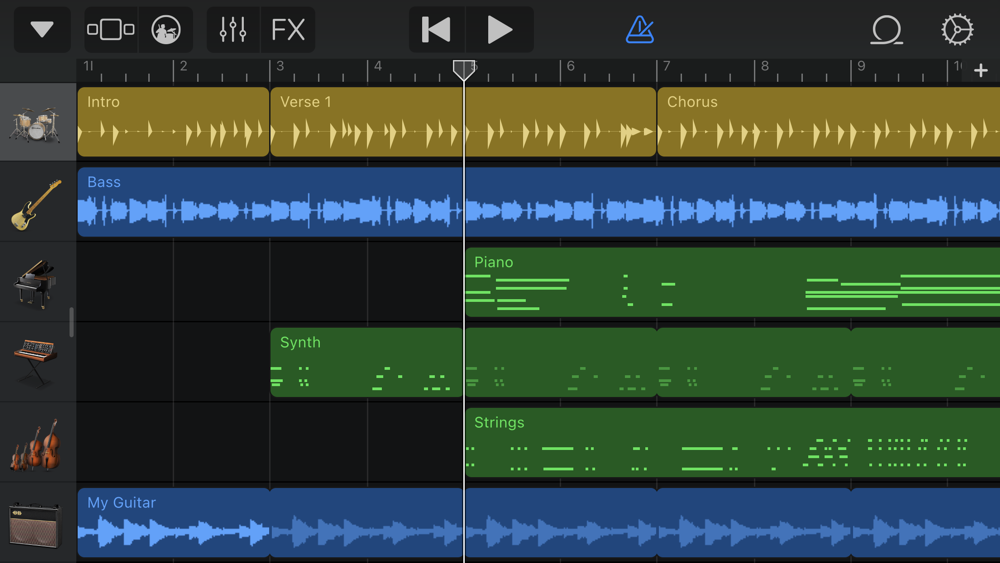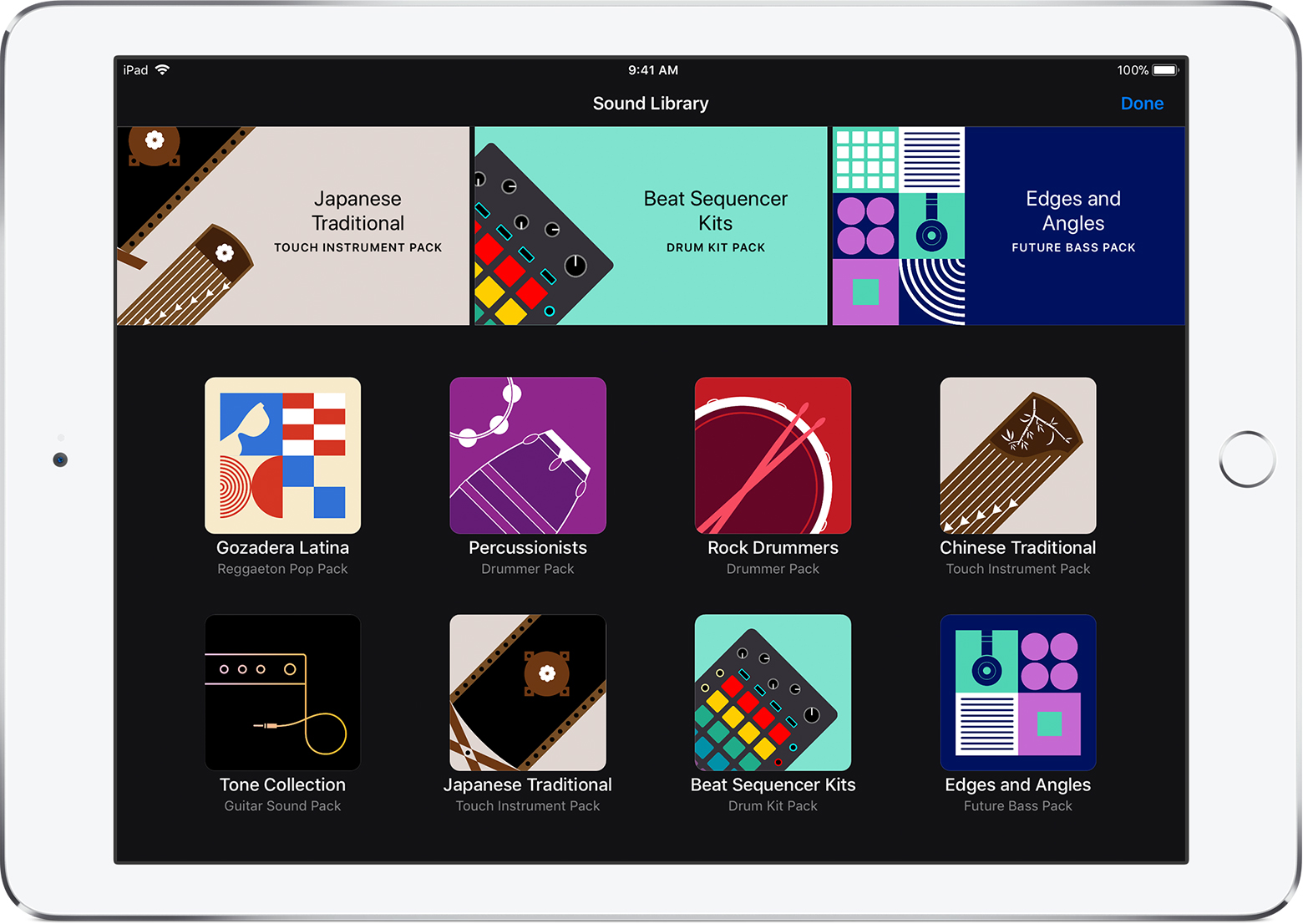GarageBand ‘09 comes with more than 100 software instruments, and each of those has dozens of presets that can sound like distinct instruments in their own right. That is a truly astounding number of sounds. In addition, Apple sells $99 Jam Packs, which offer even more instruments that seamlessly integrate with your existing ones.
- Download Instruments For Garageband Ipad Pro
- Download Instruments For Garageband
- Download Instruments For Garageband Ipad App
Download Instruments For Garageband Ipad Pro

But beyond GarageBand’s instruments, the universe of software instruments is vast, with prices that range from $500 or more for a single instrument to completely free for entire collections. This universe can be divided into roughly two galaxies: Sample-based instruments and synth-based instruments. To work in GarageBand, they simply need to support the Mac’s Audio Unit (AU) plug-in format.

I’ll introduce you to both varieties and walk you through the process of setting up and playing a collection of free sample-based instruments—Native Instruments’ Kontakt Factory Selection, and the free version of LinPlug’s synth-based instrument, Alpha 3.
Sample-based instruments
And now with the Sound Library, you can choose and download more free instrument and loop packs when new sounds are released, to help you easily craft songs in your favorite styles — all right from your iPhone, iPad, or iPod touch. Download GarageBand for iOS. Play Make music. Download these free Garageband tabla loops now and that sound can be yours. From 'Tabla Loops' Download these hot Tabla loops and samples to spice up your songs. This Indian percussion instrument will add a touch of magic to your beats and make them come to life. Inject that Bollywood sound into your mix with. The simplest way to get plenty of additional software instruments for GarageBand '11 is to buy MainStage 2 from the AppStore. Mainstage will install all six JamPacks with hundreds of additional sampler instruments (guitars, basses, horns, pianos, harps, organs, drums, many ethnic instruments, like flutes and strings, bagpipes, accordions. Our class iPad set is a little bit old for the current incarnation of GarageBand and it’s time to battle the phone policy to allow students to bring their own devices. Hopefully it can happen as we have a Year 9 music technology course for which GarageBand is the lynchpin and Mixcraft provides the full mixing console and notation capacity.
Software samplers are applications that store many small recordings of an instrument (or sound effect), and play them back in response to keyboard input. To enhance realism, creators of sample-based instruments painstakingly record each note of a real instrument at many different volumes, played in many different styles, and often with a variety of microphones.
To play a sample-based instrument, you need two components: The software instrument itself and a sampler or sample player. Samplers are sophisticated sample editors that are often pricey, while sample players are pared down versions of samplers that are often free.
Playing from Kontakt Factory Selection
First, quit GarageBand and download and install both the Kontakt 4 Player and the Kontakt Factory Selection instrument collection, both of which are available on Kontakt’s Website for free. Note that you can use the Kontakt 4 Player to play and record Factory Selection instruments (or your own recorded samples) for 15 minutes. However, you can use the Kontakt 4 Player indefinitely with other sample-based instruments that use the Kontakt format.
- Start a new GarageBand project and create a new software instrument track (Select New Track from the Track menu or hit Option-Command-N).
- Double-click the new track (the default is a Piano track, which will work for our purposes) or click on the track to highlight it and click the View Track Info button in the lower-right corner of the GarageBand interface.
- Hit the Edit Tab in the Track Info panel.
- Under Sound Generator, using the top menu (“Piano”), scroll down under Audio Unit Modules to select Kontakt 4. You’ll see the Piano image change to an Audio Unit icon (an orange sphere radiating to the right and left).
- Click on the icon to launch Kontakt.
- In Kontakt, navigate through the folders (in the Files tab on the left) to choose Factory Content.
- Navigate to a sound that interests you. Note: When Kontakt’s folders have plus signs, you can click on the plus sign or double-click the folder to open it. However, when there is no plus sign, you must double-click the folder name (not the folder) to see the individual instruments. The individual instruments will appear in the lower-left window, and will be identified by piano icons.
- Double-click an instrument to display its control panel in the right-hand window of the Kontakt interface (Be sure to drag the window left so you can see the whole thing).
- Play a few notes on your MIDI keyboard to hear the sound.
Tip: If you don’t have a MIDI keyboard installed, call up GarageBand’s onscreen keyboard by selecting Musical Typing from the Window menu (or hitting Shift-Command-K) and then play.

Synth(esizer)-based instruments

In contrast with sample-based instruments, synth-based instruments don’t play recordings; they produce (synthesize) their own sounds, after you tell them how to do so using dozens of parameters. In general, they tend to sound more otherworldly than sampler-based instruments. However, some synths use physical modeling techniques to emulate real instruments, and sound just as earthy and real as recordings.
To make things even more confusing, some sample-based instruments are called “synths,” not because they actually synthesize sound, but because they play back samples of synthesized sound.
Playing LinPlug’s Alpha 3
- Begin by quitting GarageBand and installing the free version of Alpha 3.
- Follow steps 2 through 5 above, substituting Alpha 3 for Kontakt.
- Just play (If you don’t have a MIDI keyboard installed, see tip above).
In my humble opinion, the free Alpha 3 default (as of this writing) has an interesting, spacious, and detailed sound.

Download Instruments For Garageband
Now you know what it takes to expand your instrument horizons; the universe is the limit!
[David Weiss is a San Francisco Bay Area based freelance writer.]